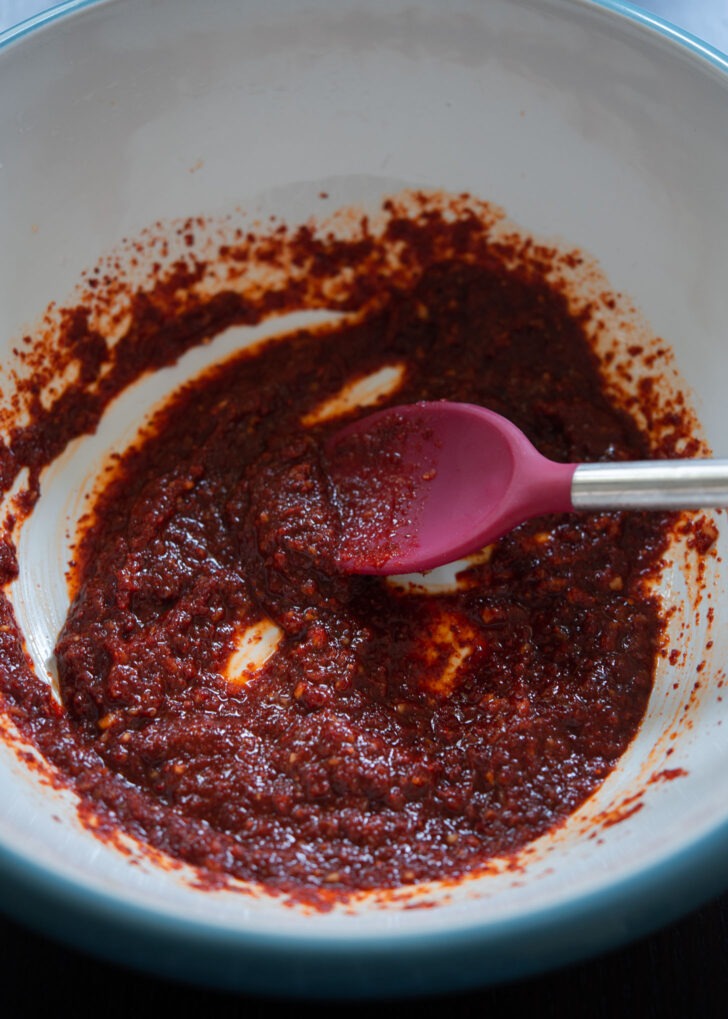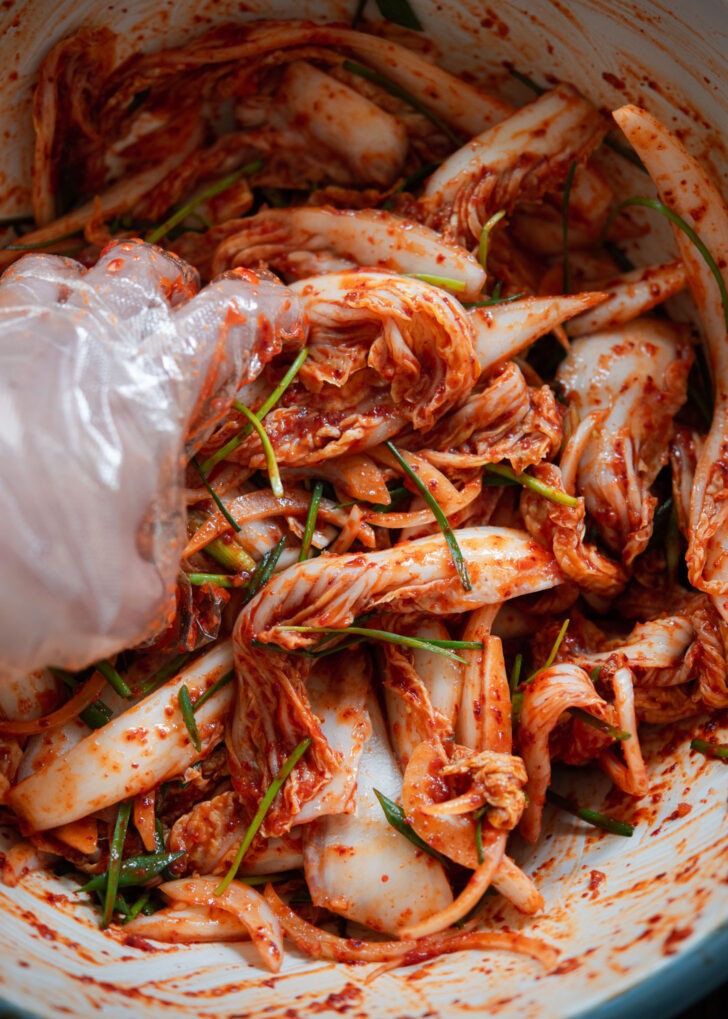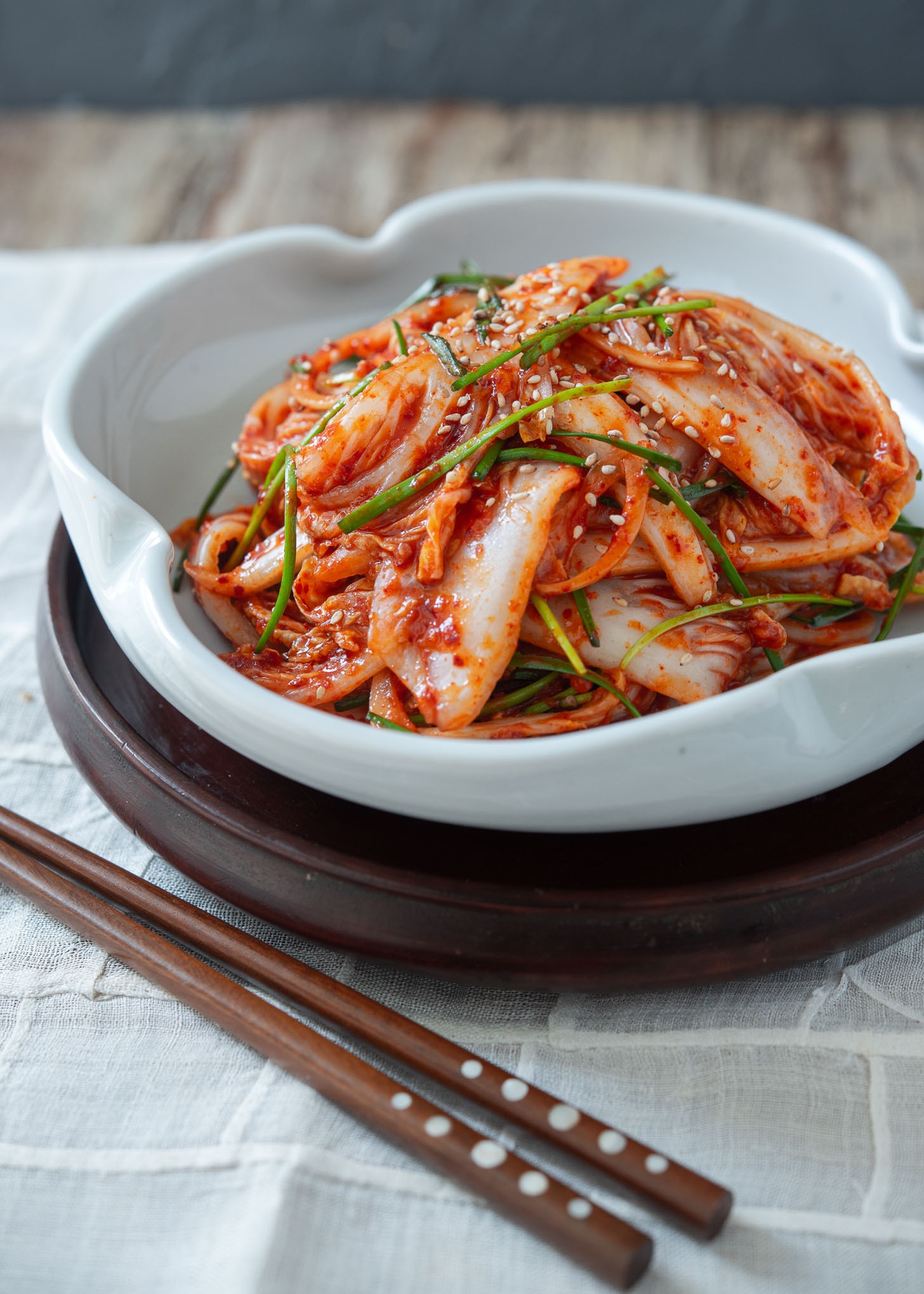Fresh Kimchi Salad (Geotjeori)
Kimchi salad, or geotjeori, is a quick and easy version of traditional kimchi that still packs a bold and spicy flavor. This easy recipe allows you to savor the vibrant and spicy flavors of good kimchi without any complications.

Geotjeori is a type of fresh kimchi salad that is made with crunchy and spicy cabbage. Unlike traditional kimchi, which is usually fermented for several days or weeks, geotjeori is typically made and consumed on a same day or within a few days.
This means that it has a fresh and crisp texture, with all of the delicious and tangy flavors of kimchi.

Geotjeori in Korean Cuisine
Although traditional kimchi and geotjeori are made with napa cabbage, their purposes differ.
While traditional kimchi is meant to be fermented over a period of time, geotjeori should be consumed within a few days of preparation to fully enjoy its refreshing and crisp texture.
This simple yet flavorful dish pairs well with many popular Korean dishes, such as bulgogi, doenjang jjigae (soybean paste stew), and grilled mackerel fish.
It is especially complementary to bossam (boiled pork belly) and kalguksu (Korean knife noodles), and is often served as a must-have side dish with noodle soups and bone marrow soups.

The cabbage
The main ingredient of geotjeori is napa cabbage, also known as “al-baechu (알배추)” in Korean, which translates to “heart of cabbage”. Summer napa cabbage is the preferred variety, as it is smaller and has thinner and more tender leaves, perfect for making kimchi salad.
If young cabbages are not available, you can use full-grown napa cabbage, with only the inner tender parts for the salad. Reserve the tough outer leaves for other dishes, such as turnip green doenjang guk (simply replace the turnip green in the recipe to cabbage).
Recipe Tips for Kimchi Salad (Geotjeori)
- Brine the cabbage with both salt and sugar: This will shorten the brining time and add more flavor to the cabbage.
- Use two types of fish sauce: Combining two different fish sauces brings more umami to the dish. However, if you only have one type of fish sauce, it will still work fine.
- I used Korean anchovy sauce and tuna sauce.
- Add sheen with corn syrup: In addition to adding proper sweetness to the salad, corn syrup also provides a beautiful sheen to the dish.
- If corn syrup is not available, use sugar in half the amount.
- Add sesame oil: If you plan to consume the salad on the same day you made, try adding a little bit of sesame oil at the end. The nutty fragrance provides an extra layer of flavor to the dish, making it a more gourmet tasting kimchi salad.

Ingredients and Substitutions:
- Young napa cabbage: Look for those with yellow leaves.
- Onion, Asian chives, and green onion: Add savory notes to the dish. You can use one or a combination of all three.
- Korean Coarse Sea Salt: If not available, replace with kosher salt, but use only 1/3 of the amount.
- Sugar: Helps to brine the cabbage faster and adds sweetness.
- Korean Fish Sauce: Adds umami flavor to the kimchi. I recommend using two different types if possible for more flavor depth. (See recipe tips above)
- Garlic and ginger: Add savory notes to the dish.
- Korean Chili Flakes (Gochugaru): A must-have ingredient for making kimchi and geotjeori.
- Corn Syrup: Adds luster and sweetness. Replaced with sugar if not available.
- Korean Plum Extract (optional): Deepens the flavor of the dish.
- Sesame Oil and Toasted Sesame Seeds: Optional add-ins.
How to make Kimchi salad (geotjeori)


Step 1. Cut napa cabbage
- Start by separating the cabbage leaves and cutting each leaf with a sharp knife into long, vertical shapes that include both the stem and leaf parts.


Step 2. Brine with salt and sugar mixture
- Combine salt and sugar in a small bowl.
- In a large mixing bowl, layer the cabbage pieces with the salt mixture in portions, reserving 1 tablespoon for later.
- Sprinkle 1 cup of water over the cabbage, toss gently, and press the cabbage down, and sprinkle the remaining salt mixture on the top.
- Let the cabbage soak in the brine for 35-45 minutes, turning it over once during this time.


Step 3. Rinse and Drain
- Rinse and drain the cabbage in running water 2 times and squeeze out the excess water.


Step 4. Make seasoning paste
- In a large mixing bowl, combine all the seasoning sauce ingredients and mix well.
- Add the drained cabbage, onion, chives, and green onion (if using).


Step 5. Toss and serve
- Using your hand, toss everything to mix well.
- If desired, add sesame oil and toasted sesame seeds and toss again.
- Serve the fresh kimchi salad with rice and other Korean dishes. Enjoy the refreshing, tangy taste of geotjeori!

Dishes to serve with Geotjeori
- Korean boiled pork belly (Bossam)
- Knife noodle soup (Kalguksu)
- Ox tail bone marrow soup
- Korean BBQ beef (Bulgogi)
- Soybean paste stew (Doenjang Jjigae)

Storage Tips
Store freshly made geotjeori in an airtight container in the refrigerator for up to one week. However, please note that while it can still be enjoyed after one week, it will begin to ferment.
Love this recipe? Rate it and share your experience in the comments below! On Instagram? Tag me to showcase your creation. For more delicious recipes, subscribe to our newsletter!

Fresh Kimchi Salad (Geotjeori)
Recipe Video
Ingredients
- 1 head (1.7 lb, 800 g) young napa cabbage
- 5 tbsp Korean coarse sea salt
- 1 tbsp sugar
- 1 cup (240 ml) water
- 1/2 onion, thinly sliced
- 1 oz (28 g) Asian garlic chives, sliced, optional
- 3 green onion, sliced
- 2 tsp sesame oil, optional
- 1 tbsp toasted sesame seeds, optional
For seasoning paste
- 6 tbsp Korean chili flakes (gochugaru)
- 2 tbsp Korean anchovy sauce
- 1 tbsp Korean tuna sauce, or Korean anchovy sauce
- 1 1/2 tbsp minced garlic
- 1/2 tbsp ginger paste
- 2 tbsp corn syrup, or 1 tbsp sugar
- 1 tbsp Korean plum extract (maeshil cheong), optional
- 3 tbsp water
Instructions
- Start by separating the cabbage leaves and cutting each leaf into long, vertical shapes that include both the stem and leaf parts.
- Next, combine salt and sugar in a small bowl. In a large mixing bowl, layer the cabbage pieces with the salt mixture in portions, reserving 1 tablespoon for later. Sprinkle 1 cup of water over the cabbage, toss gently, and press the cabbage down, and sprinkle the remaining salt mixture on the top. Let the cabbage soak in the brine for 35-45 minutes, turning it over once during this time.
- Drain and rinse the cabbage in running water 2 times and squeeze out the excess water.
- To make the seasoning paste, combine all the seasoning sauce ingredients in a large mixing bowl, and mix well. Add the drained cabbage, onion, chives, and green onion (if using) and toss to mix well. If desired, add sesame oil and toasted sesame seeds and toss again.
- Serve the fresh kimchi salad with rice and other Korean dishes. Enjoy the refreshing, tangy taste of geotjeori!
Notes
- Store freshly made geotjeori in an airtight container in the refrigerator for up to one week. However, please note that while it can still be enjoyed after one week, it will begin to ferment.

